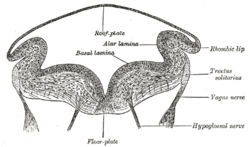- Solitary nucleus
-
Brain: NUCLEUS OF THE SOLITARY TRACT 
The cranial nerve nuclei schematically represented; dorsal view. Motor nuclei in red; sensory in blue. 
Transverse section of medulla oblongata of human embryo. Latin ''nucleus tractus solitarii medullae oblongatae NeuroNames hier-739 MeSH Solitary+Nucleus NeuroLex ID birnlex_1429 The solitary tract and nucleus are structures in the brainstem that carry and receive visceral sensation and taste from the facial (VII), glossopharyngeal (IX) and vagus (X) cranial nerves.
Contents
Anatomy
The nucleus of the solitary tract, or NTS (Latin: nucleus tractus solitarii), is located along the length of the medulla oblongata (with a small portion in the lower pons). The solitary tract runs in the middle of the nucleus, creating a speck of white matter (axons of the tract), surrounded by grey matter (the nucleus). This stands out on a stained section, which is where the name solitary comes from.
The NTS is divided into a rostral gustatory nucleus and caudal region of neurons. Sub regions of the NTS can be related to the distribution of inputs - particularly contacts from cranial primary afferent neurons (see below) related to cardiovascular, respiratory and gastrointestinal functions. There is some degree of localization within the caudal region so that many cardiovascular neurons sit near the midline of the nucleus, and many respiratory related neurons are located laterally within the nucleus.
Inputs to the NTS
In addition to afferent taste information from nerves VII, IX and X, the NTS also handles primary afferent signals from a variety of visceral regions and organs. These afferents include chemoreceptors in the carotid (via IX) and aortic bodies (via X) as well as stretch receptors from the aorta and carotid arteries called arterial baroreceptors. In addition, chemically and mechanically sensitive neurons with endings located in the heart, lungs, airways, gastrointestinal system, liver and other viscera send axons via cranial nerves (IX and X) chiefly that directly enter the brainstem to form synapses within the caudal two-thirds of the NTS. Neurons that synapse in this nucleus mediate the gag reflex, the carotid sinus reflex, the aortic reflex, the cough reflex, the baroreceptor and chemoreceptor reflexes, several respiratory reflexes and reflexes within the gastrointestinal system regulating motility and secretion. Information about the gut wall, as well as stretch of the lungs and dryness of mucous membranes, also synapses at the NTS. These first central neurons within the NTS can participate in autonomic reflexes that may be as simple as two central neurons with the second neuron being an efferent or motor neuron that projects back directly to the organ such as the heart forming some of the simplest reflex pathways in the brain.
Outputs from the NTS
Information goes from the NTS to a large number of other regions of the brain including the paraventricular nucleus of the hypothalamus and the central nucleus of the amygdala, as well as to other nuclei in the brainstem (such as the parabrachial area and other visceral motor or respiratory networks).
Additional images
See also
External links
Human brain: rhombencephalon, myelencephalon: medulla (TA A14.1.04, GA 9.767) Dorsal SurfacePosterior median sulcus · Posterolateral sulcus · Area postrema · Vagal trigone · Hypoglossal trigone · Medial eminenceafferent: GVA: VII,IX,X: Solitary/tract/Dorsal respiratory group · SVA: Gustatory nucleus · GSA: VIII-v (Lateral, Medial, Inferior)
efferent: GSE: XII · GVE: IX,X,XI: Ambiguus · SVE: X: Dorsal · IX: Inferior salivatory nucleusGrey: otherWhite: Sensory/ascendingWhite: Motor/descendingVentral White: Motor/descendingVentral respiratory group · Arcuate nucleus of medulla · Inferior olivary nucleus · Rostral ventromedial medullaSurfaceGrey: Raphe/
reticularNerves of head and neck: the cranial nerves and nuclei (TA A14.2.01, GA 9.855) olfactory (AON->I) optic (LGN->II) oculomotor
(ON, EWN->III)trochlear (TN->IV) no significant branchestrigeminal
(PSN, TSN, MN, TMN->V)abducens (AN->VI) no significant branchesfacial (FMN, SN, SSN->VII) near origininside
facial canalvestibulocochlear
(VN, CN->VIII)glossopharyngeal
(NA, ISN, SN->IX)before jugular fossaafter jugular fossavagus
(NA, DNVN, SN->X)before jugular fossaafter jugular fossaaccessory (NA, SAN->XI) hypoglossal (HN->XII) Sensory system: Gustatory system (TA 15.4, GA 10.991) Tongue Path medulla: Solitary tract (VII, IX, X) · Solitary nucleus (Gustatory nucleus)
pons: Central tegmental tract · Parabrachial nucleus (Hypothalamus, Amygdala)
thalamus: Ventral posteromedial nucleus
cerebrum: Posterior limb of internal capsule · Gustatory cortexOther Categories:
Wikimedia Foundation. 2010.


